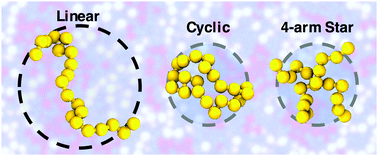当前位置:
X-MOL 学术
›
Soft Matter
›
论文详情
Our official English website, www.x-mol.net, welcomes your
feedback! (Note: you will need to create a separate account there.)
Macromolecular ‘size’ and ‘hardness’ drives structure in solvent-swollen blends of linear, cyclic, and star polymers†
Soft Matter ( IF 2.9 ) Pub Date : 2017-12-18 00:00:00 , DOI: 10.1039/c7sm02199b Thomas E. Gartner 1, 2, 3, 4 , Arthi Jayaraman 1, 2, 3, 4, 5
Soft Matter ( IF 2.9 ) Pub Date : 2017-12-18 00:00:00 , DOI: 10.1039/c7sm02199b Thomas E. Gartner 1, 2, 3, 4 , Arthi Jayaraman 1, 2, 3, 4, 5
Affiliation

|
In this paper, we apply molecular simulation and liquid state theory to uncover the structure and thermodynamics of homopolymer blends of the same chemistry and varying chain architecture in the presence of explicit solvent species. We use hybrid Monte Carlo (MC)/molecular dynamics (MD) simulations in the Gibbs ensemble to study the swelling of ∼12 000 g mol−1 linear, cyclic, and 4-arm star polystyrene chains in toluene. Our simulations show that the macroscopic swelling response is indistinguishable between the various architectures and matches published experimental data for the solvent annealing of linear polystyrene by toluene vapor. We then use standard MD simulations in the NPT ensemble along with polymer reference interaction site model (PRISM) theory to calculate effective polymer–solvent and polymer–polymer Flory–Huggins interaction parameters (χeff) in these systems. As seen in the macroscopic swelling results, there are no significant differences in the polymer–solvent and polymer–polymer χeff between the various architectures. Despite similar macroscopic swelling and effective interaction parameters between various architectures, the pair correlation function between chain centers-of-mass indicates stronger correlations between cyclic or star chains in the linear–cyclic blends and linear–star blends, compared to linear chain–linear chain correlations. Furthermore, we note striking similarities in the chain-level correlations and the radius of gyration of cyclic and 4-arm star architectures of identical molecular weight. Our results indicate that the cyclic and star chains are ‘smaller’ and ‘harder’ than their linear counterparts, and through comparison with MD simulations of blends of soft spheres with varying hardness and size we suggest that these macromolecular characteristics are the source of the stronger cyclic–cyclic and star–star correlations.
中文翻译:

大分子的“尺寸”和“硬度”驱动线性,环状和星形聚合物的溶剂溶胀共混物的结构†
在本文中,我们应用分子模拟和液态理论来揭示在存在明确溶剂种类的情况下,具有相同化学性质和链结构不同的均聚物共混物的结构和热力学。我们在Gibbs系综中使用混合蒙特卡罗(MC)/分子动力学(MD)模拟研究了约12000 g mol -1线性,环状和4臂星形聚苯乙烯链在甲苯中的溶胀。我们的仿真表明,在各种体系结构之间宏观溶胀反应是无法区分的,并且与已公开的通过甲苯蒸汽对线性聚苯乙烯进行溶剂退火的实验数据相匹配。然后,我们在《不扩散核武器条约》中使用标准的MD模拟与聚合物参考相互作用位点模型(PRISM)理论合奏沿着以计算有效的聚合物-溶剂和聚合物的聚合物弗洛里-赫金斯相互作用参数(χ EFF)的这些系统。正如在宏观膨胀的结果看到的那样,有在聚合物-溶剂和聚合物的聚合物无显著差异χ EFF在各种架构之间。尽管各种体系结构之间具有相似的宏观膨胀和有效的相互作用参数,但是链质量中心之间的对相关函数表明,与线性链-线性链相比,线性-环状混合物和线性-星形混合物中的环状或星形链之间的相关性更强相关性。此外,我们注意到相同分子量的环状和四臂星形结构的链级相关性和回转半径具有惊人的相似性。我们的结果表明,循环链和星形链比线性链更“小”和“更硬”,
更新日期:2017-12-18
中文翻译:

大分子的“尺寸”和“硬度”驱动线性,环状和星形聚合物的溶剂溶胀共混物的结构†
在本文中,我们应用分子模拟和液态理论来揭示在存在明确溶剂种类的情况下,具有相同化学性质和链结构不同的均聚物共混物的结构和热力学。我们在Gibbs系综中使用混合蒙特卡罗(MC)/分子动力学(MD)模拟研究了约12000 g mol -1线性,环状和4臂星形聚苯乙烯链在甲苯中的溶胀。我们的仿真表明,在各种体系结构之间宏观溶胀反应是无法区分的,并且与已公开的通过甲苯蒸汽对线性聚苯乙烯进行溶剂退火的实验数据相匹配。然后,我们在《不扩散核武器条约》中使用标准的MD模拟与聚合物参考相互作用位点模型(PRISM)理论合奏沿着以计算有效的聚合物-溶剂和聚合物的聚合物弗洛里-赫金斯相互作用参数(χ EFF)的这些系统。正如在宏观膨胀的结果看到的那样,有在聚合物-溶剂和聚合物的聚合物无显著差异χ EFF在各种架构之间。尽管各种体系结构之间具有相似的宏观膨胀和有效的相互作用参数,但是链质量中心之间的对相关函数表明,与线性链-线性链相比,线性-环状混合物和线性-星形混合物中的环状或星形链之间的相关性更强相关性。此外,我们注意到相同分子量的环状和四臂星形结构的链级相关性和回转半径具有惊人的相似性。我们的结果表明,循环链和星形链比线性链更“小”和“更硬”,











































 京公网安备 11010802027423号
京公网安备 11010802027423号